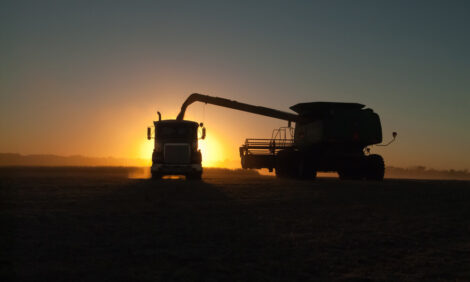



CME: USDA Reports Made Big Revisions
US - The USDA report issued on Friday contained a number of big revisions to the projections for both corn supply and use for next year, write Steve Meyer and Len Steiner.The USDA estimate for corn yields was below the average
of analyst expectations and some 22.6 bushels per acre or 15%
lower than the July estimate. This was one of the largest one
month revisions in yields and indicative of the sharp deterioration
in corn crop conditions during late June and for much of July.
While some analysts caution that the final crop may be even worse
than the current USDA estimates indicate, current yields may end
up being relatively close to the final numbers that will be tabulated at the end of the year. One item that may end up changing is
the estimate of corn acres which will not be harvested. USDA lowered the number of harvested acres by 1.5 million acres but that
was on the high side of pre-report estimates. The current projected
ratio of harvested to planted acres is 90.7%, compared to 91.4% a
year ago. In 1988, the year often compared to the current drought
ravaged corn, the ratio of harvested to planted acres was 86% while
in 1983 (another major drought year) the ratio was 85.5%. The
ratio of harvested to planted acres has been trending higher in the
last 20 years. Yet, some analysts expect the final number of harvested acres to be smaller than the current estimate. A ratio of
88%, 2 percentage points higher than in 1988 to account for the
trend, would peg total harvested acres at 84.8 million, about 2.6
million acres lower than the current USDA estimate, the equivalent of 317 million bushels of corn. With a balance sheet projecting
minimum pipeline supplies, any further reductions in corn production could put significant upward pressure on corn prices.
Markets will continue to focus on the supply picture in the
short term. Resolving the demand side of the equation will
be especially challenging given the level of demand reductions needed across the board. USDA lowered corn use across
the three main use categories, feed, ethanol and exports. Feed demand is expected to be hit the most, with corn use expected to decline some 725 million bushels from the July estimate and now
down 475 million bushels (10.4% from a year ago). Some have argued that the impact of the corn supply reductions on feed demand
will not be as severe because part of the ethanol use will flow back
into feed via ethanol by-products, such as DDGs. The argument is
that for three bushels of corn used to make ethanol, one bushel goes
back into the feed supply via DDGS. USDA projects corn use for
ethanol in 2012/13 at 4.5 billion bushels, about 725 million bushels
less than in the July report and some 475 million bushels less than
a year ago. The combined corn feed/ DDG supply in 2011/12 is calculated at 6.05 billion bushels of corn equivalent (4.55 corn + (5
ethanol * 30% DDG). In 2012/13, that corn/DDG supply is estimated at 5.425 billion bu. corn equivalent, a 10.3% reduction.
Even when accounting for DDGs, there is no escaping the dramatic impact that the short corn crop will have on the livestock
and poultry sector. The USDA estimate of a 10% reduction in
ethanol use does not reflect expectations for a waving of the ethanol mandate, USDA never makes such speculation in their estimates. Rather, it reflects the expected impact of higher corn prices on ethanol profits and the use of stockpiled Renewable Identification Numbers (RINs) by refiners. By some estimates, there
are about 1 billion bu. corn equivalent of such numbers out there.
USDA also expects corn exports to decline some 250 million bushels or 16% from a year ago. There have been some reports of major corn export shipments recently and it remains to be seen how
world buyers respond. Wheat world supplies are not as abundant
and are much more expensive than they were a year ago.








